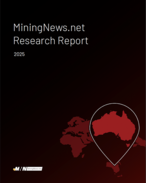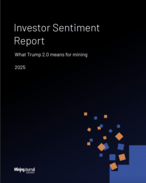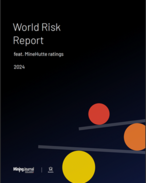It only lasted thirty minutes in late Friday trading but Dryblower is concerned that gold's brief peek at a price above US$3000 an ounce is a two-edged sword, good for gold bugs today, but bad for everyone else tomorrow.
If the price keeps rising, which seems likely, then gold miners might also have a problem because governments are awfully short of cash and that could see gold company profits being the target of a revived attempt at a mineral resources supertax.
Macquarie Bank was quick to update its gold price tip last week, lifting its September quarter forecast to US$3500/oz.
Other banks will follow as they try to outdo each other with bullish gold price predictions that will come from the Buzz Lightyear school of predictions – "to infinity and beyond".
The problem, which will soon surface, is that gold shares a property with its close relation, copper, as a metallic forecaster of future trends.
Copper has a well-earned reputation as a bellwether of overall economic activity because it has so many industrial uses, hence the nickname Dr Copper, with a rising price sometimes seen as a sign of strong global growth, though sometimes because of a supply shortage or price manipulation.
Gold performs a similar trick, but in reverse, with a rising price sometimes seen as a sign that the world is running off the rails with a slowdown on the way.
Right now the signals are a mixed. Copper is edging closer to its all-time high of $5.06 a pound reached in May last year, trading at $4.92/lb on Friday, around the same time gold cracked the US$3000/oz barrier.
Dealing with the Tariff Kid
Both metals are being heavily influenced by the wildly erratic tariff policies of the US president, Donald Trump, who continues with his impersonation of the Karate Kid (tariffs on, tariffs off).
Investors in the US were first to react to the on/off tariff threat, buying gold following reports of a tariff on imports from London and Switzerland, leading to a bizarre three-way shuffle of 400/oz London bars being sent to Switzerland for conversion into the one kilogram bars being sent to the US, where they are preferred.
It is that trade, driven by Trump's tariff threat, which led to reports of a London gold shortage that helped lift the price.
A similar event is occurring in copper only this time the issue is real with Trump hitting copper imports with a 25% tariff, then threatening to double it on Canadian metal to 50% before returning to 25%.
It's stating the bleeding obvious, but no-one can successfully run a business when you don't know the cost of raw materials, and that also applies to anyone planning to develop a mine without knowing the price of steel and other essential equipment.
What Trump is really doing with his ‘novel' approach to running the world's biggest economy is re-stoking fear of inflation which many people believed a few months ago was under control and more likely to fall than rise.
Fear of inflation
Fear of inflation returning is coming through clearly in surveys of consumer expectations and can also be measured in a 10% fall in the US stock market caused largely by households limiting their spending because they don't like the outlook.
Gold loves an economic climate like that created in the first three months of Trump's presidency which is why Dryblower dubbed him Goldfinger Trump last month.
But here lies the real problem, because Trump has another inflation creating trick up his sleeve and that is to push ahead with massive tax cuts funded by rolling back government services.
The uncertainty of what Trump might do next has flipped the mood of investors and financial markets from positive to negative – another boost for gold as its safe haven qualities shine through.
In Australia, as it heads towards a federal election the risk of inflation returning, along with higher interest rates, is being heightened as both major parties make unfunded spending promises, a factor in the abrupt end last month of what had been a strong stock market recovery.
Undoing the good work
Much of the good work of 2023 and '24 which saw the overall market rise by 25% has been trashed by a 10% fall in the local market over the last four weeks, with the potential for a steeper fall to come, especially if the US market keeps falling.
The numbers which most alarm Dryblower are the price-to-earnings (PE) multiples which Christopher Joye mentioned in his weekend column in the Australian Financial Review.
A long-term average PE is said to be 17-times (share price divided by earnings), less than half the measure of the U.S. market which had a PE of 36-times before the recent correction.
Even now the US average PE is 34 with a return to 17 requiring a big increase in earnings (unlikely) or a bigger fall in shares prices (likely).
It's numbers like that which tell Dryblower that the stock market has become a higher risk place than it normally is and that investors are starting to duck for the cover of cash and the world's ultimate form of cash – is the global currency called gold.





















DRYBLOWER
"To infinity and beyond": Dryblower and the Trump effect on gold
No-one can successfully run a business when you don’t know the cost of raw materials
Credits: MNN
It only lasted thirty minutes in late Friday trading but Dryblower is concerned that gold's brief peek at a price above US$3000 an ounce is a two-edged sword, good for gold bugs today, but bad for everyone else tomorrow.
If the price keeps rising, which seems likely, then gold miners might also have a problem because governments are awfully short of cash and that could see gold company profits being the target of a revived attempt at a mineral resources supertax.
Macquarie Bank was quick to update its gold price tip last week, lifting its September quarter forecast to US$3500/oz.
Other banks will follow as they try to outdo each other with bullish gold price predictions that will come from the Buzz Lightyear school of predictions – "to infinity and beyond".
YOU MIGHT ALSO LIKE
The problem, which will soon surface, is that gold shares a property with its close relation, copper, as a metallic forecaster of future trends.
Copper has a well-earned reputation as a bellwether of overall economic activity because it has so many industrial uses, hence the nickname Dr Copper, with a rising price sometimes seen as a sign of strong global growth, though sometimes because of a supply shortage or price manipulation.
Gold performs a similar trick, but in reverse, with a rising price sometimes seen as a sign that the world is running off the rails with a slowdown on the way.
Right now the signals are a mixed. Copper is edging closer to its all-time high of $5.06 a pound reached in May last year, trading at $4.92/lb on Friday, around the same time gold cracked the US$3000/oz barrier.
Dealing with the Tariff Kid
Both metals are being heavily influenced by the wildly erratic tariff policies of the US president, Donald Trump, who continues with his impersonation of the Karate Kid (tariffs on, tariffs off).
Investors in the US were first to react to the on/off tariff threat, buying gold following reports of a tariff on imports from London and Switzerland, leading to a bizarre three-way shuffle of 400/oz London bars being sent to Switzerland for conversion into the one kilogram bars being sent to the US, where they are preferred.
It is that trade, driven by Trump's tariff threat, which led to reports of a London gold shortage that helped lift the price.
A similar event is occurring in copper only this time the issue is real with Trump hitting copper imports with a 25% tariff, then threatening to double it on Canadian metal to 50% before returning to 25%.
It's stating the bleeding obvious, but no-one can successfully run a business when you don't know the cost of raw materials, and that also applies to anyone planning to develop a mine without knowing the price of steel and other essential equipment.
What Trump is really doing with his ‘novel' approach to running the world's biggest economy is re-stoking fear of inflation which many people believed a few months ago was under control and more likely to fall than rise.
Fear of inflation
Fear of inflation returning is coming through clearly in surveys of consumer expectations and can also be measured in a 10% fall in the US stock market caused largely by households limiting their spending because they don't like the outlook.
Gold loves an economic climate like that created in the first three months of Trump's presidency which is why Dryblower dubbed him Goldfinger Trump last month.
But here lies the real problem, because Trump has another inflation creating trick up his sleeve and that is to push ahead with massive tax cuts funded by rolling back government services.
The uncertainty of what Trump might do next has flipped the mood of investors and financial markets from positive to negative – another boost for gold as its safe haven qualities shine through.
In Australia, as it heads towards a federal election the risk of inflation returning, along with higher interest rates, is being heightened as both major parties make unfunded spending promises, a factor in the abrupt end last month of what had been a strong stock market recovery.
Undoing the good work
Much of the good work of 2023 and '24 which saw the overall market rise by 25% has been trashed by a 10% fall in the local market over the last four weeks, with the potential for a steeper fall to come, especially if the US market keeps falling.
The numbers which most alarm Dryblower are the price-to-earnings (PE) multiples which Christopher Joye mentioned in his weekend column in the Australian Financial Review.
A long-term average PE is said to be 17-times (share price divided by earnings), less than half the measure of the U.S. market which had a PE of 36-times before the recent correction.
Even now the US average PE is 34 with a return to 17 requiring a big increase in earnings (unlikely) or a bigger fall in shares prices (likely).
It's numbers like that which tell Dryblower that the stock market has become a higher risk place than it normally is and that investors are starting to duck for the cover of cash and the world's ultimate form of cash – is the global currency called gold.
RELATED ARTICLES
THEMES:
TOPICS:
< PREVIOUS ARTICLE
Dryblower: War metals rise with the global arms race
NEXT ARTICLE >
Dryblower: Australia mining's "Dirty Harry" tariff moment arrives next week
Get the Mining News Newsletter delivered free each day
FROM OUR PARTNERS
RESOURCE STOCKS
Rox Resources accelerates towards gold production
RESOURCE STOCKS
Growing gold producer Horizon Minerals eyes mid-tier status